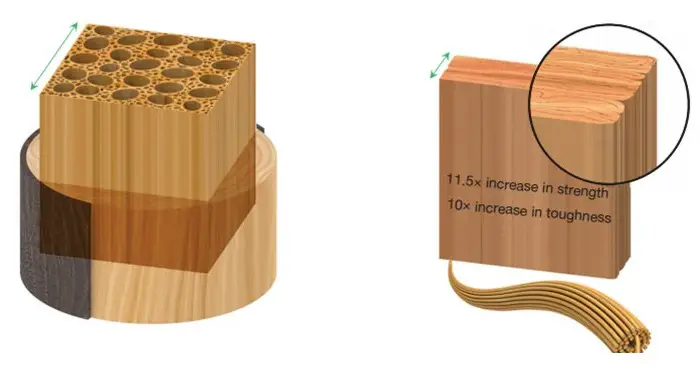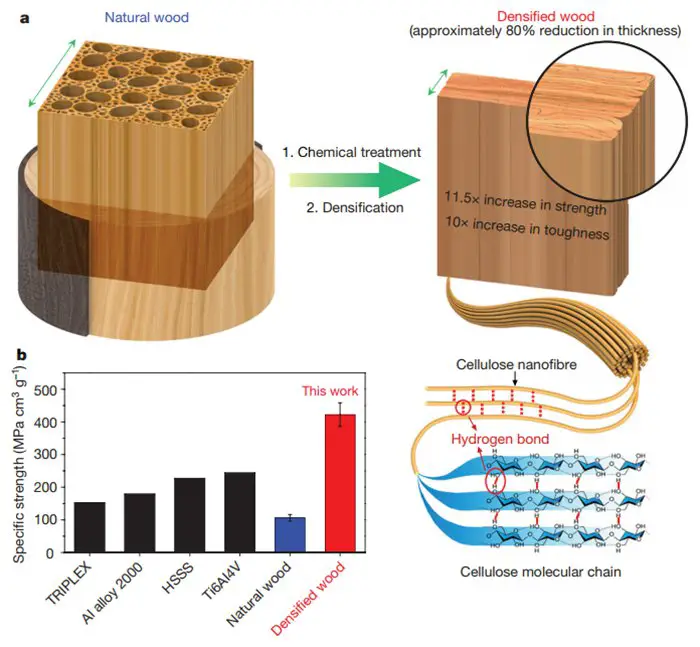Science & Tech
Engineers Create Method of Making Wood as Strong as Steel, Even Bulletproof

Engineering scientists reportedly have invented what they call a new type of “super wood.” It is said to be 10 times stronger than regular wood, and is being promoted as an innovation that could be a practical replacement for steel and harder building materials.
They call it “densified wood.” To compress wood like this, a certain chemical treatment and then a heated process of compression occurs. “The resulting chemical bonds make the wood strong enough to one day be used in buildings and vehicles,” according to Science Alert. The research was published in the journal where everything is published, in Nature.
The engineers fired projectiles similiar to bullets at their densified wood, and report that the material causes the projectile to become lodged in it, rather than going straight through it. They suggest advancements in armor plating could arise from this.

University of Maryland senior researcher Liangbing Hu said:
“This new way to treat wood makes it 12 times stronger than natural wood and 10 times tougher. This could be a competitor to steel or even titanium alloys, it is so strong and durable. It’s also comparable to carbon fibre, but much less expensive.”
“It is both strong and tough, which is a combination not usually found in nature,” Teng Li of the University of Maryland, another team member added.
“It is as strong as steel, but six times lighter. It takes 10 times more energy to fracture than natural wood. It can even be bent and moulded at the beginning of the process.”
So what chemicals exactly are used to make densified wood? There are two steps: natural wood is boiled in a mixture of sodium sulphite and sodium hydroxide, kind of similiar to the process of creating wood pulp for paper.
Then, the walls between individual cells in the wood are collapsed during a phase of compression. New chemical bonds are encouraged by heat as the wood continues to undergo compression. Remember how plants have strong cell walls?
Polymers beneficial to the wood’s strength are preserved during this process, and polymers that allow the new wood to reform are stripped out.
The science behind it apparently lies in several hydrogen atoms creating bonds to nanofibers of cellulose. However, they claim the chemical reactions are actually complex, despite how simple and inexpensive the process is.
The technique also reportedly works on many different types of wood. That’s very good if you think about hemp. More trees don’t need to be cut down, but what if this type of technology could be applied to other plant based materials?
Ever heard of hempcrete?
Other engineering scientists unrelated to the study commented on the technique. According to Huajian Gao of Brown University in Rhode Island:
“It is particularly exciting to note that the method is versatile for various species of wood and fairly easy to implement. The [published] paper provides a highly promising route to the design of lightweight, high performance structural materials, with tremendous potential for a broad range of applications where high strength, large toughness and superior ballistic resistance are desired.”
In conclusion a lot of scientific research these days can be seen as taking technology too far, or manipulating nature too far for the ends of whoever funded the research, but not this.
Some technologies genuinely advance the ability of regular people to live prosperous lives, and this would probably fall into that category: a technology that is useful, harmless, and can be decentralized.
(Image credit: Science Alert)
Typos, corrections and/or news tips? Email us at Contact@TheMindUnleashed.com
